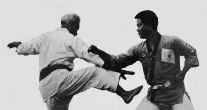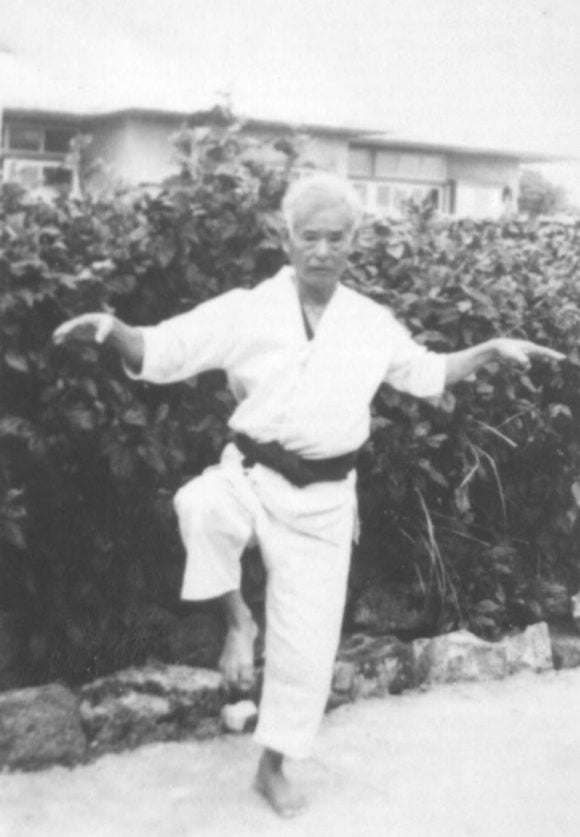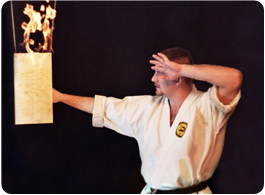Interviewer: Can you tell me some more about your kata?
Sensei: I teach the Matsumura kata. The kata that I teach now arepinan shodan, pinan nidan, naihanchi shodan, naihanchi nidan, patsai-sho and dai, chinto, gojushiho, kusanku, rohai ichi-ni-san, and last, the hakutsuru.
The last one is my favorite kata that I demonstrate – because it is easier to do. When I was young, the best kata was the kusanku. This is the Matsumura kusanku — the older version that is not done much now.
 I also teach bo, sai, tuifa, kama, nunchaku, kusarigama and suruchin. My favorite weapons form is tsukenbo (I learned that from Komesu Ushi) but in the old days it was the furi-gama or kusari-gama. We, on Okinawa, use a hand made rope to tie the kama to the hand or wrist. In Japan they use an iron chain but this is too cumbersome and can damage the student that practices that method.
I also teach bo, sai, tuifa, kama, nunchaku, kusarigama and suruchin. My favorite weapons form is tsukenbo (I learned that from Komesu Ushi) but in the old days it was the furi-gama or kusari-gama. We, on Okinawa, use a hand made rope to tie the kama to the hand or wrist. In Japan they use an iron chain but this is too cumbersome and can damage the student that practices that method.
I knew Taira Shinken very well before he died. I taught him some of my older forms. In 1970 I formed the All Okinawa Kobujutsu Association. I hope that this will spread all over the U.S. and mainland Japan. I am also a member of the Ryukyu Historical Society. We are trying to preserve the “hogen” dialect. Many young Okinawans no longer understand or even speak the old Okinawan language anymore. It is shameful.
[It should also be noted that Soken preferred to speak in his native dialect of Hogen. He often stated that he did not care for the Japanese language that much. — Editor]Interviewer: Sensei, you say that Shorin-ryu Matsumura Seito Karate-do is an old style with many secrets. Since you also say that you are getting old, what do you feel needs to be passed on to modem day students of Okinawan karate?
Sensei: There are many secrets in karate that people will never know and will never understand. These ideas are really not secret if you train in Okinawa under a good teacher. You will see the teacher use these so called secret techniques over and over again until they will
become common knowledge to you. Others will look at it and marvel that it is an advanced or secret technique to them. That is because they do not have good teachers or their teachers have not researched their respective styles.
Karate is much more than simple punching and kicking and blocking. It is the study of weaponry and of grappling. Weaponry and empty hand fighting go together. How can you learn about defending against a weapon unless you are familiar with what the weapon can do?
[Soken-sensei used the Spanish word for wrestling when describing this art-form but I felt that a more apt term would be grappling – much like Japanese-style jujutsu. He stated that many people often referred to the Okinawan grappling arts as Okinawan-style wrestling mainly because it was never systematized and looked like a free-for-all form of fighting.Soken-sensei continued by stating that as a youngster on Okinawa, that grappling was taken very seriously and it was not uncommon for individuals to suffer broken arms and legs as a result of taking part in this light form of entertainment. Soken-sensei would use the terms
“te-kumi” or “gyaku-te” as identifying this old Okinawan art form.
The danger of reminding Soken-sensei of the “old methods of playing” was that he would often stand up, grab you, and then apply one of these painful methods of common people entertainment – he enjoyed watching Americans “squeaking like a mouse who had been stepped on.” — Editor]
Hohan Soken sensei – Sai kamae
Grappling is an old Okinawan custom that is commonly practiced in all villages. In America, the children played at “cowboys and indians. ” In Okinawa we played by grappling with each other. We would have contests for grapplers in every village and one village would pit their best grapplers against all comers. It was very exciting.
Some people see the grappling and call it Okinawan jujutsu but this is incorrect. It is the old method called “ti.” Ti { this is pronounced in the old dialect of Okinawa — it sounds like the word “tea” — ed. } practice was very common during the turn of the century but with the Japanese influences, these methods have almost
disappear.
Interviewer: Sensei, any recommendations for us — Americans?
Sensei: Yes, but you won’t like it! Americans want to learn too much, too fast. You want more this and more that. You have a life time to learn. Learn slowly. Learn correctly. Look. Listen. Practice, practice, practice. Don’t be a rash American, but a smart American. Never be in a
hurry to learn, OK? Learning in a hurry can cause pain. Do you know about pain? Let me show you!
DEMONSTRATION: At this time, Soken demonstrated basic “ti” methods involving the use of the “sharp forearm bone” and the “thumbing” methods. All of them hurt – a lot! He had an uncanny command of the human anatomy and would use the thumb to hit the various nerves in the shoulder, the forearm and the sides of the body. He laughed a lot when doing this – he really enjoyed grappling.
A number of techniques resembled aikiJutsu movements and instead of moving in on the opponent, he would step backwards and would use his body weight to increase the power of the technique. He would always block using what he called a “double bone block” and counter with a thumb technique or a grappling technique that took you to the ground.
Soken stated that he could drive an individual through the ground or just simply throw him on the ground either way, the opponent was at a distinct disadvantage. He could then subdue you with techniques like kicks or move away from the confrontation.
Taken from the second interview:
Interviewer: Sensei, your kata is very distinct and beautiful to see. I have a question that has been bothering me since the Okinawan Expo.
Remember when we saw the bo fighters in Nago. They used the names of many of the kata that are practiced today but they are very different.
The only thing that appears to be the same is the name.
Sensei: Yes, they are the same and they are not the same. You say you lived on Okinawa for five years but you cannot understand the Okinawan people. In the old days, when we were really Okinawan and not Japanese,
many of the old people were not smart — or as smart as they are today. They did not travel, they did not watch TV, many never left their villages unless they had to. What we did have was festivals… village festivals. Everyone would come and watch and learn.
These village people would watch the other fancy city people practice their ti or their methods of weaponry. Say, like… well, … Yes, a kata that they knew or practice had a number of movements. They come to the city and see and city kata with some of the same movements. The city kata had a name… and maybe their kata did not have a name. So, they would go back and … yes, you now understand. They would name their kata after the city kata because they had a few of the same movements.
Some of their kata had five or maybe ten movements. Taira, my friend, would go to the village and learn these kata. He says that he learned 500 kata this way! Wah! This is true but he also liked to tell stories. Some of these kata had only 3 or maybe 5 movements. 500 kata, yes, now that is funny but he was a history collector. He knew them but he didnt understand them.
Hohan Soken kobudo weapons
Interviewer: Was Taira a friend or student? He is very famous for his weaponry in Japan.
Sensei: Yes, Taira… he knew a lot of kata, huh. Huh, huh, huh… Yes, he is dead, you know that. He would watch my kata all the time and try to learn my tsuken style stick. But I would trick him and change the kata, wah!! … just like that. He would still come back and look some more in the hopes of being able to take it back. When we both were young — our karate was very good. When we both got old, our weaponry was
good.
Why do you want to know these things — these old ideas, these old ways. Their old value was to survive a challenge match. You punch me and I will show you … good karate means you also test yourself through pain. Like pain… in good karate… movements are quick, like a mongoose. If you are slow, you can die. If you are quick, then there is a chance that you and your family (???) will live.
Interviewer: Yes, fighting must have been very different at the beginning of this century.
Crane spreads its wings
Sensei: Yes, you don’t know these old days. In a fight… if you would lose, the loss would be suffered by your family. They could die. You would work hard to support the family working all day, If you were injured or killed while fighting, then your family would starve… maybe
even die. Okinawa life was very hard.
Now, the young people want to be Japanese. They don’t speak the Okinawan language. They are lazy. They do not respect old people, they have no pride in being Okinawan. Yes, we are a poor country but that is no excuse in putting our culture in the dark and saying we are someone that we are not. This is no good.
NOTE: The second interview ends here. Sensei’s mind begins to wander and he begins to get angry. I believe it has to do with painful, old memories that are brought up by the questions.
The following interview with Hohan Soken is made by Ernest Estrada.



Trackbacks for this post